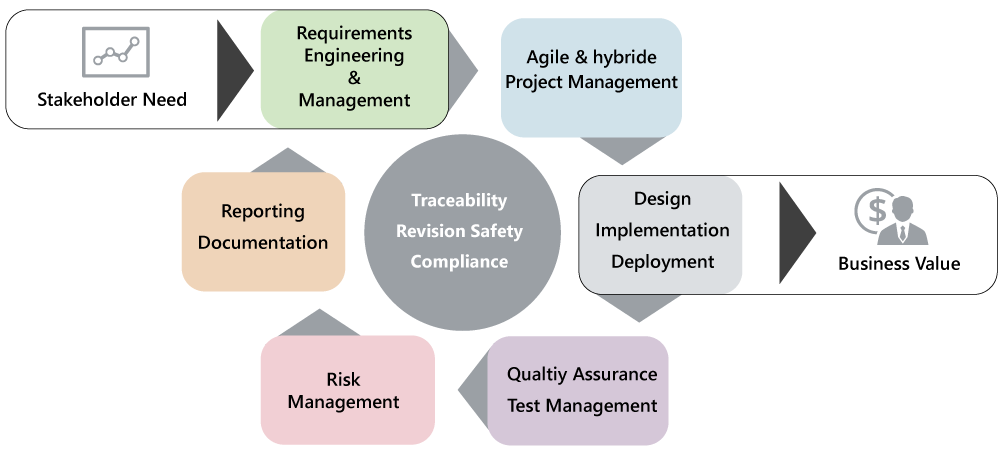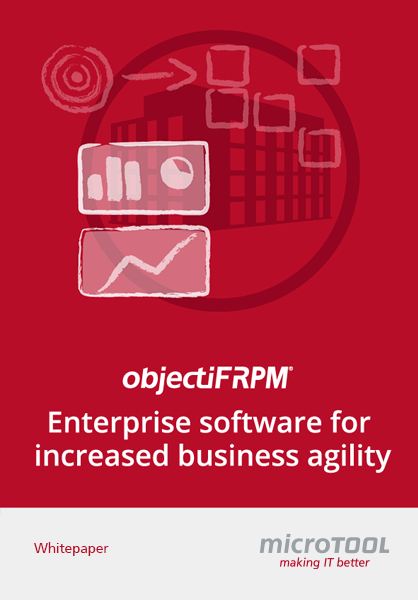From Business Need to Business Value.
How is application lifecycle management interpreted and what can tools offer?

Converting business needs into value with software and systems - that is the goal of application lifecycle management.
Application lifecycle management (ALM) describes the whole lifecycle of an application, from the needs of the stakeholders to its discontinuation.
In the course of developing the solution, many tasks arise – stakeholder management, requirements engineering, project management, change management, quality assurance and testing, etc.
What Is Application Lifecycle Management?
Application lifecycle management is dealing with the management of an application over its entire lifetime – from the needs of the stakeholders to operation and right up to discontinuation. Digitization is ushering in a number of deep changes in many companies – changes that affect business processes and models as well as products. IT departments need to respond with new and adjusted systems faster than ever before. The goal is clear: To identify the business needs and to turn them into value for the stakeholders and the company. This requires communication, cooperation and mutual understanding between business and the IT department. When dealing with ALM, it is important that the pathway from the needs phase to the final IT system or product is transparent and traceable for all participants. You can achieve this with systematic application lifecycle management (ALM).
Your stakeholders’ goals and requirements drive the application lifecycle – the requirements are derived from the business needs. Requirements engineering models like SysML and UML diagrams or text-orientated recording with forms can be used for the analysis of stakeholders and their goals. An important aspect of application lifecycle management is being able to handle requirements, changes and priorities flexibly. The technique with the least overhead – known as scaling – consists of implementing multiple teams who work independently of each other in terms of content, but synchronized in time periods. Transparency and traceability of the results are just as important – secured in the practical application of ALM with tools that offer realtime repositories with multiple query and evaluation possibilities, as well as intergrated version management and configuration management for all artifacts of the application lifecycle.
Application lifecycle management describes the whole lifecycle of an application, from the needs of the stakeholders to the discontinuation of the solution.
The Different Interpretations of Application Lifecycle Management
Application lifecycle management is interpreted differently by different ALM providers. Basically, it comprises the whole period in which an organization invests both time and money into a solution, from the needs of the stakeholders, to the development of ideas, the definition of a business case, the planning and development of a solution right up to the preparation, implementation, service and discontinuation of the solution. The following disciplines or tasks come into effect:
- Stakeholder identification, stakeholder analysis and stakeholder communication
- Idea management
- Business case
- Requirements engineering
- Design, draft solution and artitecture, for example with mediums like SysML and UML
- Project management – agile, classic or hybrid
- Resource management
- Change management
- Issue management
- Configuration management
- Version management
- Code generation
- Quality assurance and testing
- Reporting
- Build management, release management and deployment
- Customer support including maintenance and software maintenance
- Benefits management i.e., solution evaluation
- Discontinuation, if necessary, replacement through another solution
The structure for these disciplines and tasks form the project management, process optimization and the workflow management. For these disciplines and tasks, there are different ALM tools – from isolated solutions to integrated tools.
Application lifecycle management pursues the goal of making needs-based applications available as quickly as possible, to then efficiently maintain and service them.
Knowledge to go
All about application lifecycle management with objectiF RPM
Planning and Control in Application Lifecycle Management
How do you want to work and what should you look out for in an ALM tool?
If you deal with application lifecycle management, it is important to develop an understanding of which ALM support it is exactly that you need. Application lifecycle management pursues the goal of making needs-based applications available as quickly as possible, to then efficiently maintain and care for them. In other words: you want to plan and control the lifecycle with its tasks and disciplines with as little effort as possible, for example, in project management with the specification of the project plan as a Gantt chart and when using workflows with activities and artifacts or when tailoring your processes in an ongoing project.
Agile or classical, scrum or waterfall – do you make the choice from project to project or even from one phase of the application lifecycle to the next? Is your organization one that prefers agile development or one that conducts its planning and sales with a classical approach? Or do you build embedded systems and take an agile approach to software development while sticking to a waterfall model in your hardware development? If you have to deal with these or similar scenarios then you require flexible, adaptable ALM-support.
There are a lot of tools and solutions available for the many tasks in an application’s lifecycle.You can use the available software in your business with interfaces between tools, or decide for intergrated solutions. There isn’t software for all disciplines and tasks in ALM. If you are interested in a software, the following aspects are of importance:
Stakeholders want to know what they’re getting and when, sponsors need statements about the performance of the organization. Answers give state-based evaluations of the requirements and metrics – like burn-up charts and extending and earned value analyses. If presenting the course and progress of the project is important to you, you should look for ALM tools that have:
- Dashboards with performance indicators (Planned and actual cost, completed value, etc),
- A roadmap of all the projects of your organization
- Central management of requirements and artifacts
- Net plan generation
- Employee pool planning
- Intergrated time recording
Goals, requirements, use cases, test cases, test plans, test runs, test results, user stories, issues, work packages, milestones, releases, sprints etc. – the list of artifact types in the application lifecycle is long. And it can get even longer with your own artifact types. If adaptability and expansion are important for you, you should look for an ALM tool that can:
- Generate documents from diagrams and artifacts at the press of a button
- Offer custom project templates and patterns for consistent procedures
- Enable a glossary for standardized concepts in the project
- Support the use of project guides
- Offer the possibility to define unique custom artifacts and forms
To exchange artifacts amongst decentralized teams without allowing direct access to your project for organizational reasons, or for an interaction with other tools that you have already implemented and don’t want to replace, you need features and interfaces. If working in a team and exchanging information is important for you, then you should look for ALM tools that have:
- UML/SysML diagrams for requirements and system architecture that improve understanding
- Export and import features, like the Rest API, ReqIF interface, Excel interface or JIRA interface
- A task manager to execute time-dependent automatized commands
- Application capability as on-premises software (either with a client server and/or with a browser) or as SaaS (Software as a Service)
Get to know application lifecycle management software now!
Are you looking for a solution with which you can better plan, control and trace the development of your products and applications? Is it important for you to be able to quickly respond to changed or new requirements? Do you want to let all project participants see what is happening in the project and where it is at the moment? Then objectiF RPM is just the right solution for you.
With objectiF RPM you control your application lifecycle. Record requirements easily and structured with forms, visualize connections with modern diagrams, plan your projects agilely, classically or as a hybrid and work together in local or distrubuted teams. Securely with your Windows client or in your browser. Simple and secure.
Try it out right now. Free for 30 days!

